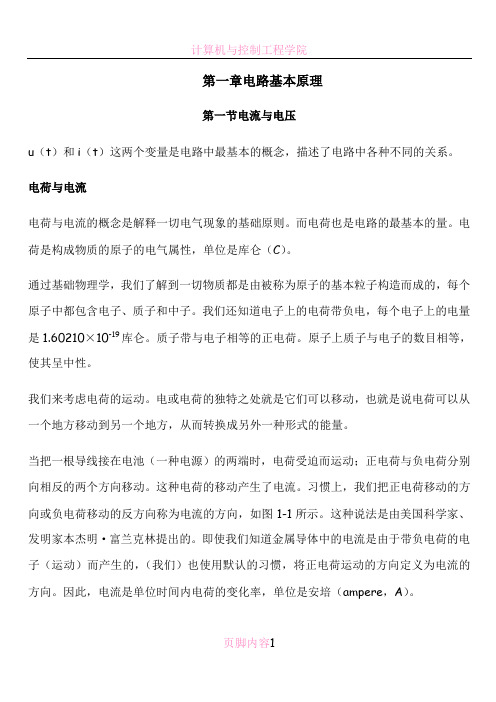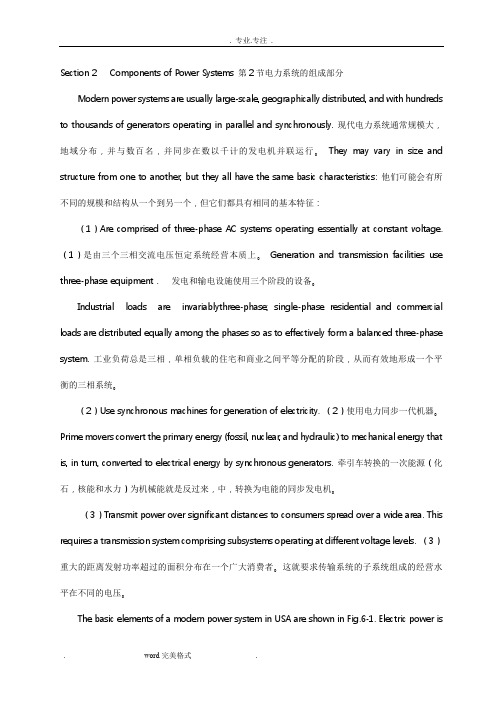电气工程及其自动化专业英语第6章6-2翻译
电气工程与自动化专业英语中文翻译

第一章电路基本原理第一节电流与电压u(t)和i(t)这两个变量是电路中最基本的概念,描述了电路中各种不同的关系。
电荷与电流电荷与电流的概念是解释一切电气现象的基础原则。
而电荷也是电路的最基本的量。
电荷是构成物质的原子的电气属性,单位是库仑(C)。
通过基础物理学,我们了解到一切物质都是由被称为原子的基本粒子构造而成的,每个原子中都包含电子、质子和中子。
我们还知道电子上的电荷带负电,每个电子上的电量是1.60210×10-19库仑。
质子带与电子相等的正电荷。
原子上质子与电子的数目相等,使其呈中性。
我们来考虑电荷的运动。
电或电荷的独特之处就是它们可以移动,也就是说电荷可以从一个地方移动到另一个地方,从而转换成另外一种形式的能量。
当把一根导线接在电池(一种电源)的两端时,电荷受迫而运动;正电荷与负电荷分别向相反的两个方向移动。
这种电荷的移动产生了电流。
习惯上,我们把正电荷移动的方向或负电荷移动的反方向称为电流的方向,如图1-1所示。
这种说法是由美国科学家、发明家本杰明·富兰克林提出的。
即使我们知道金属导体中的电流是由于带负电荷的电子(运动)而产生的,(我们)也使用默认的习惯,将正电荷运动的方向定义为电流的方向。
因此,电流是单位时间内电荷的变化率,单位是安培(ampere,A)。
在数学上,电流i、电荷q和时间t的关系为dq(1-1)i=dt将等式的两边同时进行积分,则可得到电荷在时间t和t0之间的变化。
有idt(1-2)q== 0tt在等式(1-1)中我们给电流i的定义表现了电流不是一个定值量,电荷随时间的变化不同,电流也与之呈不同的函数关系。
电压、电能与电功率使电子在导体中定向运动需要做功或能量转换。
功由外电动势提供,最典型的就是图1-1中的电池。
外电动势也可理解为电压或电位差。
电路中,a、b两点之间的电压U ab等于从a到b移动单位电荷所需能量(所做的功),有dw(1-3)U ab=dqw代表电能,单位是焦耳(J);q代表电量。
电气工程和自动化专业英语第6章6_2翻译

Section 2 Components of Power Systems 第2节电力系统的组成部分Modern power systems are usually large-scale, geographically distributed, and with hundreds to thousands of generators operating in parallel and synchronously. 现代电力系统通常规模大,地域分布,并与数百名,并同步在数以千计的发电机并联运行。
They may vary in size and structure from one to another, but they all have the same basic characteristics: 他们可能会有所不同的规模和结构从一个到另一个,但它们都具有相同的基本特征:(1)Are comprised of three-phase AC systems operating essentially at constant voltage. (1)是由三个三相交流电压恒定系统经营本质上。
Generation and transmission facilities use three-phase equipment . 发电和输电设施使用三个阶段的设备。
Industrial loads are invariablythree-phase; single-phase residential and commercial loads are distributed equally among the phases so as to effectively form a balanced three-phase system. 工业负荷总是三相,单相负载的住宅和商业之间平等分配的阶段,从而有效地形成一个平衡的三相系统。
电气工程及其自动化专业英语第6章6-3翻译

Section 3 Operation and Control of Power SystemsThe purpose of a power system is to deliver the power the customers require in real time, on demand, within acceptable voltage and frequency limits, and in a reliable and economic manner. In normal operation of a power system, the total power generation is balanced by the total load and transmission losses. The system frequency and voltages on all the buses are within the required limits, while no overloads on lines or equipment are resulted. However, loads are constantly changed in small or large extents, so some control actions must be applied to maintain the power system in the normal and economic operation state.Optimal economic operationIt is an important problem how to operate a power system to supply all the (complex) loads at minimum cost. The basic task is to consider the cost of generating the power and to assign the allocation of generation ( P Gi) to each generator to minimize the total "production cost" while satisfying the loads and the losses on the transmission lines. The total cost of operation includes fuel, labor, and mainte nance costs, but for simplicity the only variable costs usually considered are fuel costs. The fuel-cost curves for each generating unit are specified, the cost of the fuel used per hour is defined as a function of the generator power output. When hydro-generation is not considered, it is reasonable to choose the PGi on an instantaneous basis (ie always to minimize the present production cost rate). With hydro-generation, however, in dry periods, the replenishment of the water supply may be a problem. The water used today may not be available in the future when its use might be more advantageous. Even without the element of the prediction involved, the problem of minimizing production cost over time becomes much more complicated.It should be mentioned that economy of operation is not the only possible consideration. If the "optimal" economic dispatch requires all the power to be imported from a neighboring utility through a single transmission link, considerations of system security might preclude that solution . When water used for hydro-generation is also used for irrigation, nonoptimal releases of water may be required. Under adverse atmospheric conditions it may be necessary to limit generation at certain fossil-fuel plants to reduce emissions.In general, costs, security and emissions are all areas of concern in power plant operation, and in practice the system is operated to effect a compromise between the frequently conflicting requirements.Power system controlPower system control is very important issue to maintain the normal operation of a system. System voltage levels, frequency, tie-line flows, line currents, and equipment loading must be kept within limits determined to be safe in order to provide satisfactory service to the power system customers.V oltage levels, line currents, and equipment loading may vary from location to location within a system, and control is on a relatively l ocal basis. For example, generator voltage is determined by the field current of each particular generating unit; however, if the generator voltages are not coordinated, excess var flows will result. Similarly, loading on individual generating units is determined by the throttle control on thermal units or the gate controls on hydro-units. Each machine will respond individually to the energy input to its prime mover. Transmission line loadings are affected by power input from generating units and their loadings, the connected loads, parallel paths for power to flow on other lines, and their relative impedances.Active power and frequency controlFor satisfactory operation of a power system, the frequency should remain nearly constant. Relatively close control of frequency ensures constancy of speed of induction and synchronous motors. Constancy of speed of motor drives is particularly important for satisfactory performance of all the auxiliary drives associated with the fuel, the feed-water and the combustion air supply systems. In a network, considerable drop in frequency could result in high magnetizing currents in induction motors and transfor mers . The extensive use of electric clocks and the use of frequency for other timing purpose require accurate maintenance of synchronous time which is proportional to integral of frequency. As a consequence, it is necessary to regulate not only the frequency itself but also its integral. The frequency of a system is dependant on active power balance. As frequency is a common factor throughout the system, a change in active power demand at one point is reflected throughout the system by a change in frequency. Because there are many generators supplying power into the system, some means must be provided to allocate change in demand to the generators. A speed governor on each generating unit provides the primary speed control function, while supplementary control originating at a central control center allocates generation.In an interconnected system with two or more independently controlled areas, in addition to control of frequency, the generation within each area has to be controlled so as to maintain scheduled power interchange. The control of generation and frequency is commonly referred to as load-frequency control (LFC).The control measures of power and frequency include:(1)Regulation of the generator's speed governor(2)Underfrequency load shedding(3)Automatic generation control (AGC)AGC is an effective means for power and frequency control in large-scale power systems. In an interconnected power system, the primary objectives of AGC are to regulate frequency to the specified nominal value and to maintain the interchange power between control areas at the scheduled values by adjusting the output of the selected generators. This function is commonly referred to as load-frequency control . A secondary objective is to distribute the required change in generation among units to minimize operating costs.In an isolated power system, maintenance of interchange power is not an issue. Therefore, the function of AGC is to restore frequency to the specified nominal value. This is accomplished by adding a reset or integral control which acts on the load reference setting of the governors of unit on AGC. The integral control action ensures zero frequency error in the steady state. The supplementary generation control action is much slower than the primary speed control action. As such it takes effect after the primary speed control (which acts on all units on regulation) has stabilized the system frequency. Thus, AGC adjusts load reference settings of selected units, and hence their output power, to override the effects of the composite frequency regulation characteristics of the power system In so doing, it restores the generation of all other units not on AGC to scheduled values.Reactive power and voltage controlFor efficient and reliable operation of power systems, the control of voltage and reactive power should satisfy the following objectives:(1)V oltages at the terminals of all equipment in the system are within acceptable limits. Both utilityequipment and customer equipment are designed to operate at a certain voltage rating. Prolonged operation of the equipment at voltages outside the allowable range could adversely affect their performance and possibly cause them damage.(2)System stability is enhanced to maximize utilization of the transmission system.(3)The reactive power flow is minimized so as to reduce RI2 and XI2 losses to a practical minimum. This ensures that the transmission system operates efficiently, ie mainly for active power transfer.The problem of maintaining voltages within the required limits is complicated by the fact that the power system supplies power to a vast number of loads and is fed from many generating units. As loads vary, the reactive power requirements of the transmission system vary. Since reactive power can not transmitted over long distances, voltage control has to be effected by using special devices disper sed throughout the system. This is in contrast to the control of frequency which depends on the overall system active power balance.The proper selection and coordination of equipment for controlling reactive power and voltage are among the major challenges of power system engineering.The control of voltage levels is accomplished by controlling the production, absorption, and flow of reactive power at all levels in the system. The generating units provide the basic means of voltage control; the automatic voltage regulators control field excitation to maintain a scheduled voltage level at the terminals of the generators. Additional means are usually required to control voltage throughout the system. The devices used for this purpose may be classified as follows:(1)Sources or sinks of reactive power, such as shunt capacitors, shunt reactors, synchro- nous condensers, and static var compensators (SVCs). ((2)Line reactance compensators, such as series capacitors.。
电气工程专业英语+unit6

Note:①此句中lumens是光通量的计量单位。②flipping a light switch to illuminate a darkened room为现在分词短语结构,说明主语A man 的动作; 最后一句中,③adjusting the degree of accelerator depression也是现在 分词短语结构,说明主语An automobile driver的动作。
6.1 Introduction
New Words and Expressions
manual intelligent interdependent elements stimuli thermostat control aileron rudder cowl flap adj. 手动的 adj. 智能的 相互依存的元件 n. 激励 恒温控制 n. 副翼 n. 方向舵 整流罩
Note:①that applies a control signal to the plant为定语从句,修饰the agency。
6.1.1 Elementary Concept of Control Systems text
(4) The reference command or reference input is an external signal applied to a control system in order to bring about① a specific action of the plant (i.e., a specific value of the controlled variable). (5) Disturbance inputs are undesired stimuli of the plant which affect the value of the controlled variable. (6) A comparator is a control system element that compares (by addition or subtraction) two or more signals.
电气工程专业英语unit6解读

This involves the application of automation technology in the power system, such as SCADA, EMS, and DMS, to achieve real-time monitoring and control of the power system.
Article structure
VS
Unit 6涉及的词汇主要包括电气工程相关术语、工业自动化和智能制造领域的专业词汇,以及一些科技类常用词汇。
短语总结
文章中出现的短语主要包括与电气工程和工业领域相关的短语,如"power system","automation control","intelligent manufacturing"等。这些短语对于理解文章内容非常重要,需要学生重点掌握。
Electrical engineering also contributes to the progress of other fields, such as computer science, robotics, and nanotechnology. Electrical engineers design and develop the electronic components and systems that are used in these fields, making it possible for them to advance.
Circuit analysis
Circuit analysis is a fundamental skill for electrical engineers. It involves using mathematical models to analyze the behavior of electrical circuits. Circuit analysis is essential for predicting circuit performance, optimizing circuit design, and troubleshooting circuit problems.
电气工程及其自动化英语英译汉

1```In the generator mode ,it,s operating speed isslightly higger than it,s synchronous speed and ie needs magnetizing revctive pover form the symtem that it is connected to in order to suuply pover .在发电方式下他的工作速度比同步转速稍高些,并了解供电力,他需要他所连接的系统吸收磁化无功功率。
2```in the barking mode of operyetion ,a three –phase indection motor running at a steady –speedcan be brought to a quick stop by interchanging two of stator leads感应电机运行电动状态时,其转速低于同步转速,运行在发电状态时,其转速高于同步转速,这就需要从与之间相连的系统电源提供励磁的无功功率。
3```obviously ,dc machine applications are very significant,but the advantages of the dc machinemmust be weighed against its greatr initial investment cost and the maintenance problems associated with its brush-commutator system..同步是指状态运行时点击以恒定的转速和频率运行。
4```with a cylindyical rotor the reluctance of the magnetic circuit of the field is independent of itsactual diretion and relative to the direct axis.圆柱形转子的磁场磁路的磁阻与直轴有关,而与磁场的实际方向无关。
电气工程与自动化专业英语 第6章
6.2 Motor current waveforms
2
Armature voltage
The ripple voltage (纹波电压)causes a ripple current to flow in the armature, but because of the armature inductance, the amplitude of the ripple current is small. In other words, the armature presents a high impedance to a.c. voltages. This smoothing effect of the armature inductance is shown in Figure 6.2(b),
5
Text A Thyristor DC Drivers
Low power control circuits are used to monitor the principal variables(主变量) of interest (usually motor current and speed), and to generate appropriate firing pulses so that the motor maintains constant speed despite variations in the load. The ‘speed reference’ (Figure 6. 1) is typically an analogue voltage varying from 0 to 10 V, and obtained from a manual speed-setting potentiometer or from elsewhere in the plant.
2012年 电气工程及其自动化专业英语翻译
�� � ���������������������������tdp
0t
t
��w
于等率功的供提件元由或收吸件元被 t 间时到 0t 间时从 �知可 �7�1� 程方从 。实事一这衡平相率功的收吸与须必率功的路电给供提了明证次一再这 �� � �����������������������0 � p � 零于等须必和数代的率功间瞬 何任在中路电一任�因原个这于由。律定恒守量能循遵须必中路电何任在�上实事 。率功供提或放释在是件元明表�时 示所�b�3�1 图如�0<iu 或 iu��p 果如而。率功收吸在是件元明表�0>iu 或 iu�p�下 况情种这在。极正的压电进流流电�说来例惯号符源无于对�例惯号符源无为称被况情种这 。致一的示所�a�3�1 图与须必向方的流电和性极的压电 �正为号符的率功使了为。因原要重的慎谨别特时系关的 u 压电和 i 流电的示显所�a�3� 1 图析分在们我是就这�用作的要主着起性极的压电和向方的流电�时号符率功定确们我在 �负为或正为率功时何知得何如们我但。的供提件元由是 率功么那�的负是号符的率功果如�面方一另。收吸件元被或放释件元向率功么那�的正是 号符的率功个这果如 。积乘的流电的它过通和压电端两件元于等率功的供提或收吸件元一某 �率功时瞬为称被是于量变间时个是 p 率功的中 �6�1� 程方 �数函的间时是常通 i 和 u 于由
�� � ������������������������我。得求分积边两�1�1�程方由可荷电的送移所 t 间时到 0t 间时从
td �� � ��������������������������� �i qd �是系关的间之 t 间时及 以 q 荷电、i 流电�说来上学数从。的量度来位单为培安以是它�率时的荷电是就流电是于 。动流的纯单的荷电正是作看流电把即�例惯的用通循遵将们我但�的起引荷电负由是流电 的中体导属金道知在现们我然虽 。的入引林克兰富�明杰本家明发和家学科国美由是例惯一 这。示所 1�1 图如�反相向方动流的荷电负与�即也�动移的荷电正是作看流电把地便方 很以可们我 。流电了生产动移的荷电种这 。动移向方的反相朝荷电负而动移向方个一朝荷电 正 �动移使驱力外被荷电 �)源势动电种一(时上池电一某到接连线导根一把们我当 。量能的式形种一外另成换转被以可它此在�方地个一另到送移被方 地个一从以可它�是就也�性特的动运其是性特的电或荷电。动流的荷电下一虑考来们我让 。性中 电现呈子原得使同相量数子电和子质 。等相子电与上值数在量电正的带所子质而 �C21-01× 001206.1 于等上值数在且并的负是量电的子电道知还们我 。的成组子中和子质 �子电由是子 原个每且并�的成组分部造构本基的子原为称被由是质物切一知得理物础基从们我 。的量度来位单为仑库以是它�性属气电的粒微子原的质物成构是荷电 。荷电是量的本基最中路电 �即也 。念概本基的象现气电有所释解来用是念概的荷电 流电和荷电 。系关种各的路电了划刻们它�量变个两的本基最中路电是量变个两这)t(i 和)t(u 章一第
电气工程与自动化专业英语翻译
2.1翻译:电子系统基于模拟原则形成一个重要的类的电子设备。
模拟电子系统在调频接收器(FM)是一个常见的例子,尽管现代接收器包含当然数码组件,传播信号模拟。
输入一个调频接收器是一个调频信号。
信号是一个模拟,也就是说,它是一个连续函数的时间和可以有任何振幅。
许多信号电仪器,如。
电压表,电流表,瓦特计和示波器也利用模拟技术,至少在这部分。
反馈是一个重要的概念在模拟电子。
反馈是一种技术,通过获得的模拟系统可以交换其他等受欢迎的品质更广泛的带宽和线性。
没有反馈,模拟系统如FM或电视接收机,最多也只能提供性能较差。
运算放大器是一种重要的组件在模拟电子。
基本的构建块模拟电路的加上运算放大器。
在这一章中,我们将介绍一些常见的应用程序的运算放大器。
理解反馈的好处提供了基础的欣赏许多使用放大器在模拟电子。
2.21:许多制造商市场放大系统在积体电路包。
许多不同的集成电路(ic)是可用的。
其中的一些被设计用来执行一个特定的系统功能。
这包括诸如照看作为放大器,线性信号放大器,和功率放大器。
其他ICs可能执行作为一个完整的系统。
电力经营只有有限数量的外部组件都需要完整的系统,低功率音频放大器和兴奋剂放大器是这些设备的例子。
一个运算放大器或运算放大器是一种高性能、直接耦合放大器电路包含几个晶体管设备。
整个组装是建立在一个小硅衬底和打包作为一个集成电路。
ICs的这种类型能够高增益信号放大从直流至几百万赫兹。
一个运放是模块化的,多级放大装置。
操作放大提供了基本的建筑模块。
这种类型的集成电路能够高增益信号放大从直流至几百万赫兹。
一个运放是模块化的,多级放大装置。
操作放大提供了基本的建筑模块模拟电路以同样的方式,也没有和NAND 盖茨是数字电路基本构建块。
2.2.2运算放大器有几个重要属性。
他们的开环增益的能力范围,在200000年与一个输入阻抗约2 mΩ。
输出阻抗是相当低的,数值范围50Ω或更少。
他们的带宽,或者能够放大,是相当不同的频率。
电气工程及其自动化专业英语翻译
电气工程及其自动化专业英语翻译第一章u(t)和i(t)这两个变量是电路中最基本的两个变量,它们刻划了电路的各种关系。
电荷和电流电荷的概念是用来解释所有电气现象的基本概念。
也即,电路中最基本的量是电荷。
电荷是构成物质的原子微粒的电气属性,它是以库仑为单位来度量的。
我们从基础物理得知一切物质是由被称为原子的基本构造部分组成的,并且每个原子是由电子,质子和中子组成的。
我们还知道电子的电量是负的并且在数值上等于1.602100×10-12C,而质子所带的正电量在数值上与电子相等。
质子和电子数量相同使得原子呈现电中性。
让我们来考虑一下电荷的流动。
电荷或电的特性是其运动的特性,也就是,它可以从一个地方被移送到另一个地方,在此它可以被转换成另外一种形式的能量。
当我们把一根导线连接到某一电池上时(一种电动势源),电荷被外力驱使移动;正电荷朝一个方向移动而负电荷朝相反的方向移动。
这种电荷的移动产生了电流。
我们可以很方便地把电流看作是正电荷的移动,也即,与负电荷的流动方向相反,如图1,1所示。
这一惯例是由美国科学家和发明家本杰明,富兰克林引入的。
虽然我们现在知道金属导体中的电流是由负电荷引起的,但我们将遵循通用的惯例,即把电流看作是正电荷的单纯的流动。
于是电流就是电荷的时率,它是以安培为单位来度量的。
从数学上来说,电流i、电荷q以及时间t之间的关系是: dq i, ,,,,,从时间t0到时间t所移送的电荷可由方程(1,1)两边积分求得。
我们算得: dttqidt, ,,,,, ,0t我们通过方程(1,1)定义电流的方式表明电流不必是一个恒值函数,电荷可以不同的方式随时间而变化,这些不同的方式可用各种数学函数表达出来。
电压,能量和功率在导体中朝一个特定的方向移动电荷需要一些功或者能量的传递,这个功是由外部的电动势来完成的。
图1,1所示的电池就是一个典型的例子。
这种电动势也被称为电压或电位差。
电路中a、b两点间的电压等于从a到b移动单位电荷所需的能量(或所需做的功)。
- 1、下载文档前请自行甄别文档内容的完整性,平台不提供额外的编辑、内容补充、找答案等附加服务。
- 2、"仅部分预览"的文档,不可在线预览部分如存在完整性等问题,可反馈申请退款(可完整预览的文档不适用该条件!)。
- 3、如文档侵犯您的权益,请联系客服反馈,我们会尽快为您处理(人工客服工作时间:9:00-18:30)。
Section 2 Components of Power Systems 第2节电力系统的组成部分Modern power systems are usually large-scale, geographically distributed, and with hundreds to thousands of generators operating in parallel and synchronously. 现代电力系统通常规模大,地域分布,并与数百名,并同步在数以千计的发电机并联运行。
They may vary in size and structure from one to another, but they all have the same basic characteristics: 他们可能会有所不同的规模和结构从一个到另一个,但它们都具有相同的基本特征:(1)Are comprised of three-phase AC systems operating essentially at constant voltage. (1)是由三个三相交流电压恒定系统经营本质上。
Generation and transmission facilities use three-phase equipment . 发电和输电设施使用三个阶段的设备。
Industrial loads are invariablythree-phase; single-phase residential and commercial loads are distributed equally among the phases so as to effectively form a balanced three-phase system. 工业负荷总是三相,单相负载的住宅和商业之间平等分配的阶段,从而有效地形成一个平衡的三相系统。
(2)Use synchronous machines for generation of electricity. (2)使用电力同步一代机器。
Prime movers convert the primary energy (fossil, nuclear, and hydraulic) to mechanical energy that is, in turn, converted to electrical energy by synchronous generators. 牵引车转换的一次能源(化石,核能和水力)为机械能就是反过来,中,转换为电能的同步发电机。
(3)Transmit power over significant distances to consumers spread over a wide area. This requires a transmission system comprising subsystems operating at different voltage levels. (3)重大的距离发射功率超过的面积分布在一个广大消费者。
这就要求传输系统的子系统组成的经营水平在不同的电压。
The basic elements of a modern power system in USA are shown in Fig.6-1. Electric power is produced at generating stations (GS) and transmitted to consumers through a complex network of individual components, including transmission lines, transformers, and switching devices. 系统在美国一个现代化强国的基本要素是:1显示在图6 -。
电功率)产生于发电厂(GS和传播给消费者通过一个复杂网络的各个组成部分,包括输电线路,变压器和开关设备。
It is common practice to classify the transmission network into the following subsystems: Transmission system; Subtransmission system; Distribution system. 它通常的做法是分类传输网络分为以下子系统:传输系统; Subtransmission制度;分配制度。
Fig.6-1 图6 - 1Basic elements of a power system 电力系统的基本要素1The transmission system interconnects all major generating stations and main load centers in the system. 该传输系统互连所有主要发电厂在系统中心和主要负载。
It forms the backbone of the integrated power system and operates at the highest voltage levels (typically, 230 kV and above in USA). 它形成了系统的骨干力量的整合和经营水平在最高电压(通常为230千伏及以上美国)。
The generator voltages are usually in the range of 11 to 35 kV. 发电机的电压范围通常在11至35千伏。
These are stepped up to the transmission voltage level, and power is transmitted to transmission substations where the voltages are stepped down to the subtransmission level (typically, 69 to 138 kV). 这是加强宣传,电压等级输电和电力传输到传输)变电站的电压在那里下台的subtransmission水平(通常是69至138千伏。
The generation and transmission subsystems are often referred to as the bulk power system.发电和传输子系统通常称为大容量电源系统。
The subtransmisson system transmits power in small quantities from the transmission substations to the distribution substations. 该系统传输subtransmisson变电站的电力由分布在小批量的输电站通过。
Large industrial customers are commonly supplied directly from the subtransmission system. In some systems, there is no clear demarcation between subtransmission and transmission circuits. 大工业用户通常直接供应subtransmission制度。
在一些系统中,没有明确划分输电线路之间subtransmission和。
As the system expands and higher voltage levels become necessary for transmission, the older transmission lines are often relegated to subtransmission function. 随着系统的扩展和更高电压等级输电成为必需的,旧的输电线路往往沦为subtransmission功能。
The distribution system represents the final stage in the transfer of power to the individual customers. The primary distribution voltage is typically between 4.0 kV and 34.5 kV. Small industrial customers are supplied by primary feeders at this voltage level. The secondary distribution feeders supply residential and commercial customers at 120/240 V. 分配制度代表了个人客户的最后阶段中的转移权力的。
主要分布电压一般为4.0千伏和34.5千伏。
小型电压等级的工业客户提供的主要是饲养在此。
二次配电馈线供应住宅和五,商业用户在120/240Small generating plants located near the load are also connected to the subtransmission or distribution system directly. Interconnections to neighboring power systems are usually formed at the transmission system level. The overall system thus consists of multiple generating sources and several layers of transmission networks. This provides a high degree of structural redundancy that enables the system to withstand unusual contingencies without service disruption to the customers. 小型发电厂附近的负载也连接到subtransmission直接或分配制度。
系统互连到邻近的权力通常形成于水平的传输系统。
整个系统网络由多个从而产生源的传播和若干层。
这为一个客户高度结构性过剩,使系统中断承受无异常紧急服务。
三。
